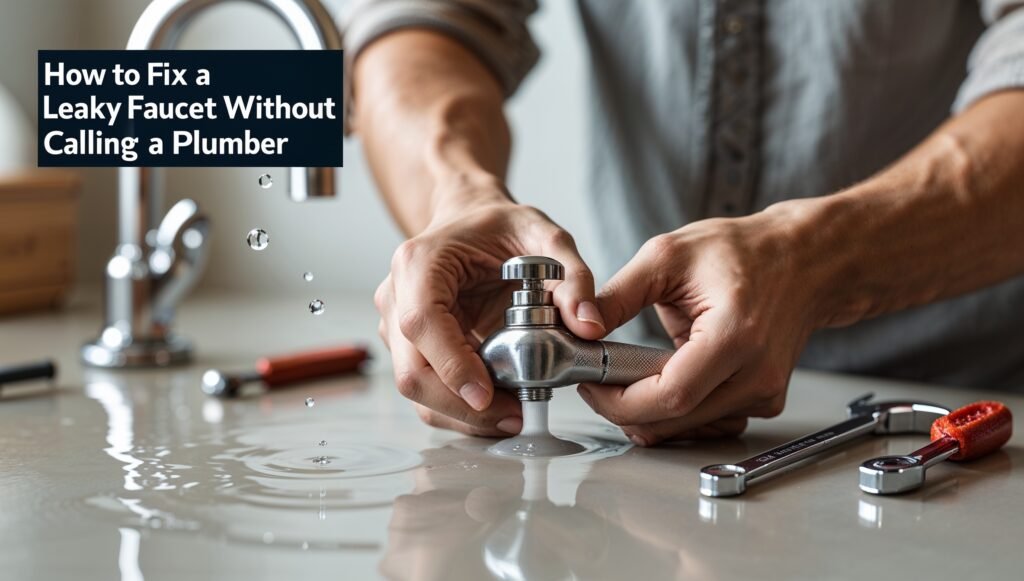
A leaky faucet might seem like a minor problem, but it can quickly lead to significant water wastage and increased utility bills. Worse, if you call a plumber to fix a simple leak, it could cost you upwards of $200 or more! Fortunately, fixing a leaky faucet is a DIY project you can easily handle, saving you money while keeping your home in top condition.
In this guide, we’ll show you how to fix that annoying drip in no time, using common tools that most homeowners already have in their toolbox. Plus, we’ll give you some essential tips for preventing future leaks.
Why Does a Faucet Leak?
Faucets typically leak due to worn-out washers, damaged seals, or loose parts. Understanding the root cause of the leak can help you determine the most efficient way to fix it. A leaky faucet can waste a surprising amount of water. In fact, even a slow drip can waste up to 3,000 gallons of water a year — that’s roughly the amount of water needed to take 180 showers! Fixing it sooner rather than later can prevent unnecessary waste and save you money on your water bill.
What You’ll Need to Fix a Leaky Faucet
Before you start, gather the necessary tools and materials:
Replacement parts (e.g., washers, seals, or cartridges, depending on the type of faucet)
Plumber’s tape
Lubricant (optional)
Once you have everything ready, it’s time to get started!
Step 1: Turn Off the Water Supply
The first thing you should always do before fixing any plumbing issue is to turn off the water supply. Look for the shut-off valve under the sink and turn it clockwise to stop the water flow. If you can’t find the valve, you may need to turn off the major water supply to your home.

Step 2: Plug the Drain
To avoid losing any small parts down the drain, use a sink plug or a rag to block the drain. This will ensure that you don’t accidentally drop a screw or washer when removing faucet components.
Step 3: Disassemble the Faucet Handle
The next step is to remove the faucet handle. Depending on the type of faucet you have, this might involve removing a decorative cap that hides the screw. Use a flathead screwdriver to pop off the cap, and then use a Philips screwdriver to remove the screw that holds the handle in place. If you’re dealing with a single-handle faucet, this step will be a little more straightforward.

Step 4: Inspect the Valve
With the handle removed, you’ll have access to the valve, which is the core of the faucet. Check for any worn-out washers or seals, which are often the culprits behind the leak. If you notice any visible damage, replace the faulty parts with new ones. If your faucet uses a cartridge system, you may need to replace the cartridge as well.
Step 5: Replace the Worn Parts
Now that you’ve identified the problem, it’s time to replace the worn parts. Head to your local hardware store and purchase a replacement washer, O-ring, or cartridge that matches the specifications of your faucet. You can also find these replacement parts online, making it even easier to get the right size. For a cost-effective option, consider buying a faucet repair kit that includes various sizes of washers and seals.

If the faucet uses a washer, simply remove the old washer and install the new the same position. If you’re working with a cartridge faucet, replace the old cartridge by carefully pulling it out and inserting the new one.
Step 6: Reassemble the Faucet
Once you’ve replaced the damaged parts, it’s time to put everything back together. Begin by inserting the valve back into its housing. Reattach the faucet handle by securing the screw in place. Finally, tighten the faucet components with your adjustable wrench to ensure everything is snug.
Step 7: Turn On the Water Supply and Test
After reassembling the faucet, turn the water supply back on. Slowly test the faucet by turning it on and off to check if the leak is fixed. If there’s still a drip, double-check that all parts are securely tightened and properly aligned. If the leak persists, it could be a sign of a more complex issue, in which case, consult a professional plumber.
Prevent Future Leaks: Essential Maintenance Tips
To prevent future leaks, consider these simple maintenance tips:
Clean your faucet regularly: Mineral buildup can cause parts to wear out faster. Clean your faucet regularly using a gentle, non-abrasive cleaner.
Check for leaks periodically. Even minor leaks can cause significant damage. Perform regular inspections to catch leaks early before they become costly problems.
Use plumber’s tape: For extra security, apply plumber’s tape around the threads when reassembling the faucet. This helps create a tighter seal and prevents leaks.
By taking these preventative steps, you can keep your faucets working properly for years to come.
Save Time and Money with Our DIY Repair Kits
If you’d like to tackle more plumbing issues around the house without the hassle of scheduling professional service calls, check out our DIY Home Repair Kits. These affordable kits include everything you need to fix common household plumbing problems, from leaky faucets to clogged drains. By doing the repairs yourself, you’ll save hundreds of dollars on service fees and enjoy the satisfaction of completing the job on your own.
Read here the DIY Plumbing Fixes Guide
Finally
Fixing a leaky faucet is a straightforward project that anyone can handle with the right tools and knowledge. By following these simple steps, you can save yourself hundreds of dollars and prevent further water damage in your home. With a little time, effort, and a few replacement parts, your faucet will be as good as new — no plumber required!
For more DIY home repair tips and to browse our collection of handy tools and repair kits, visit our FixItSmartly.com website today!
FixItSmartly.com helps everyday people save money and build confidence by tackling home and car repairs with easy, practical DIY solutions. Live smart, safe, and self-reliant — one fix at a time.
Copyright © 2025 Fixitsmartly